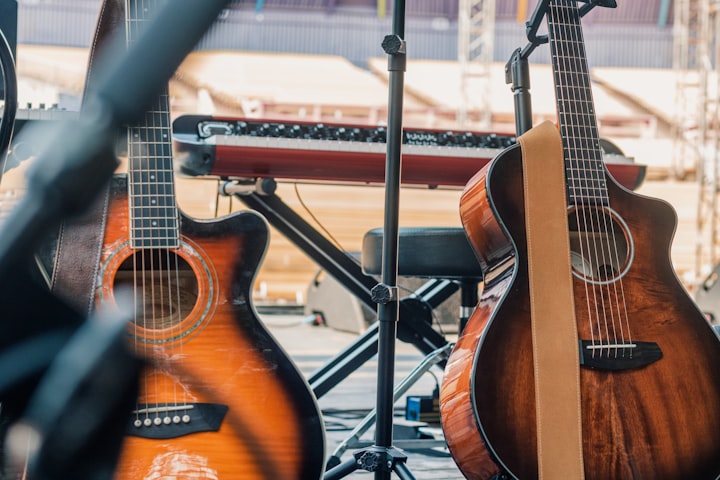
Here I will attempt to give you a few basics. You might consider taking a poetry or fiction course that explores the English language a lot deeper than is possible here. Most songwriters today are self-taught and writing skills can be improved with some schooling. Artists tend to fall into bad habits and also fail to reach their potential without some personal care. A good teacher can do wonders in taking some of the bugs out of your writing and playing.
Reading is a great aid, but again, without someone to direct you, people tend to read only what they like and don’t study things closely. Formal training and education can be a boon or a bane depending on how you handle it. Too much training kills creativity and too little training lowers the potential of the artist. Without a foundation to build on, many artists are a kite without a string – they blow away when the wind picks up.
iambic pentameter An iamb is two syllables with one weak and one strong accent.
Let’s look back to our discussion on the definition of rhythm: the pattern of recurring strong and weak accents and long and short syllables in speech. Someone who does not accent his speech would speak in a monotone voice. Ever have a teacher who killed you with his monotonous voice? An articulate speaker modulates their tones. That is, they are melodic.
Pentameter literally means “five meters.” (Remember, an iamb is two syllables?) An iambic pentameter, therefore is a verse of ten syllables (or five iambs) and would sound like this:
dee daw, dee daw, dee daw, dee daw, dee daw
My dog / and I / went down / the street / today
Sing the line and you will see that you will naturally sing it in iambic pentameter. We naturally speak in rhythm, probably not as structured as this, though listen closely to conversations and you will hear the rhythm in the speaker’s pauses and sentences.
That doesn’t mean you have to write in iambic pentameter all the time; your songs would become pretty repetitive if you did. This is just to show you that when you write you do it with a rhythm and this happens to be one of the most basic and commonly used rhythms.
simile and metaphor Simile means “same” or “similar.” When you compare two things using “like” or “as” you are using a simile. For example,
He had a head as big as a watermelon
She ran like a gazelle.
Metaphor is when you skip the “like” or “as.”
He had a watermelon for a head.
She was a gazelle on the track field.
The difference between an amateur and a professional is often found here. An amateur will use simile more often than metaphor. Metaphor is for the pros. When you get really good with metaphor you graduate to analogy.
alliteration is the repetition of the same sound at the beginning of two or more stressed syllables according to Webster’s.
Dopey Dave does drugs down by the dock.
Sally sells seashells by the seashore.
Alliteration often adds humour and flow to a verse.
personification is when you attribute human qualities to inanimate objects or ideas.
The car coughed and sputtered.
His guitar screamed and wailed.
Careful not to overdue it with either of these two elements of language because the results may be unintentionally funny or childish.
irony Being ironic is something we all do daily, often without realizing it. Life is often ironic. Daily events often cause us to marvel at the seeming contradictions of life. People say one thing and do another. Being ironic in conversation is akin to sarcasm. Irony, by definition, is the use of words to convey a meaning that is the opposite of its literal meaning.
Examples:
• Telling someone who is rude to “have a nice day”
• Walking into an empty restaurant and saying, “It’s too crowded”
• Saying during a hailstorm, “Beautiful weather we’re having”
And the perfect example from Alanis Morrissette’s song “Ironic”:
A traffic jam when you're already late A no-smoking sign on your cigarette break It's like ten thousand spoons when all you need is a knife It's meeting the man of my dreams And then meeting his beautiful wife . And isn't it ironic... don't you think? A little too ironic... and yeah I really do think...
symbolism or imagery is at the heart of poetry. Poetry is a symbolic language. If someone spoke to you in poetic language you would think he or she was nuts. If someone said to you:
To be or not to be That is the question Whether tis nobler in mind to risk the slings and arrows of outrageous fortune
You might tell them to get out of the house more often or switch to decaf. Now listen to this:
I lay waiting between turf-face and demesne wall between heathery levels and glass-toothed stone My body was braille for the creeping influences: dawn suns groped over my head and cooled at my feet
~ (Seamus Heaney, Bog Queen)
Huh? Is that even English? Even if you read the whole poem several times it’s hard to understand what the writer is trying to tell you right away. Poetry is not a giveaway art. Mystery is at its core. Look at those images: glass-toothed stone, my body was braille...Wow!
Many aspects of nature have been symbols for poets for hundreds of years: stones, mountains, rivers, as well as animals have represented different things for different cultures. The symbol of the eagle for example has been used by many cultures to represent their ideals of courage and independence. The Romans used it, the Egyptians used it and so does the US today. When an eagle is used in a song or a poem, we intuitively know what “eagle” means. It’s part of our culture, we grow up knowing what it means.
analogy is the similarity between like features of unlike things on which a comparison may be based.
The song, “Desperado” is one big analogy. The song compares two things:
1. the life of an outlaw cowboy on the run and
2. one man’s love life
The guy in the song is not just “like” a desperate cowboy in his love life, he is a desperado, with all the lingo and imagery of one too.
Hotel California, another big Eagles song is also one big metaphor.
Mirrors on the ceiling, Pink champagne on ice And she said, “We are just prisoners here of our own device” And in the master’s chambers, They gathered for the feast They stab it with their steely knives But they just can’t kill the beast.
Plateau, from Nirvana’s New York Unplugged is another example.....
Nothing on the top but a bucket and a mop And an illustrated book about birds See a lot up there but don’t be scared Who needs action when you got words
What is he talking about? We know it’s not really about a guy who lives on a cliff but what does he mean? Fascinating! For curiosity sake, I googled “Plateau lyrics meaning” and found a couple of interesting interpretations of the song. The most common idea is that the Plateau is the top of the mountain of fame or success that you climb only to discover there is nothing up there except a book, a bucket and a mop. You can chose to either read, and further enlighten yourself, or clean up, that is, make the best of the situation. The fact that there is nothing up there shows the emptiness of life at the top. All his struggle to succeed was in vain.
archetype By definition, an original pattern or model from which all things of the same kind are copied or on which they are based; prototype.
Carl Jung popularized this concept in reference to the human mind. Though computers have taught us that the mind works in binary (01010101), in reality, the deeper centers of thought and understanding function through the use of symbols or archetypes. This means that once the mind grasps a concept or series of concepts, it retains the model or blueprint for that concept and uses it to judge or understand other similar concepts. Dreams are compositions made of archetypes: Houses, policemen, strange animals, voices: all these things subconsciously mean something.
Pink Floyd’s The Wall is a concept album with many layers of interpretation. The concept of a wall as a barrier between musician and audience, a barrier between people in general, a barrier in male/female relationships, and even a physical barrier like the Berlin Wall. Wow! Can you ever go places with that idea! It gets us in the gut because it resonates on so many levels.
To Summarize, the process of growth for a writer involves mastery of all of these elements of language. And the direction of growth or maturity can be shown like this:
simile >> metaphor >> symbolism >> analogy >> archetype
Though the distinction between these elements is somewhat blurred, and the process not necessarily written in stone, generally a writer moves from concrete ideas based in reality to abstract ideas based on observation, experience and understanding of human behaviour. In the beginning of human history, basic concepts of harvest, hunting, rain, sun, moon, love, hate, anger, war, jealousy, sex, death were so rooted in the daily fabric of existence that their symbolic meanings only became evident over time. As culture develops, the symbolism, mythology and complexity of language of the culture also develops. The job of the poet or songwriter is to appeal to the basic themes that human beings experience; to dig up these subconscious desires and dreams and feed them back to the audience.
We’ll leave off here with a great example from the first verse of U2’s “With or Without You:”
See the stone set in your eyes See the thorn twist in your side I'll wait for you Sleight of hand and twist of fate On a bed of nails she makes me wait And I wait without you
***
If you enjoyed this story you can find more of my writing here and here

About the Creator
Richard Revelstoke
Author, musician, activist. Played in rock bands now into jazz. Lives in Vancouver, Canada working on third novel. www.richardrevelstoke.com






Comments
There are no comments for this story
Be the first to respond and start the conversation.